|

VENETIAN MASKS
The Venetian masks were know most notably for the
Commedia dell'arte, but they were used not only during
carnival. The Venetian masks were worn even in other periods of the year
and for other special events. The Serenissima Republic was always
quite permissive about this, even if it created a Magistrato alle Pompe
in order to prevent the excesses.
This tradition was founded in 1514 to control excessive pomposity and the
costumes of the prostitutes. This magistrate was organised by three
Provveditori that imposed, among other rules, the black colour to
gondolas. The Venetian masks were used specially in the eighteenth century
but even previously, some of them can be seen in actual editions of carnival.
The habit of masking in Venice came from the wish of transgression or simply
in order not getting recognized. Of course the Venetian masks were used in
the stage plays, above all in Carlo Goldoni's comedies that greatly contributed
to make them celebrated not only in Italy but worldwide.
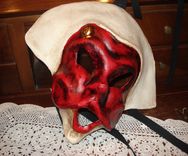
Those who made the Venetian masks at the age of the Serenissima
were the "Mascareri", associated in the Arte dei Maschereri
since 1436. In the city there are hundreds of shops selling Venetian masks, but
only a few shops can boast of real maschereri working using the ancient style,
with papier mache. Venetian masks' prices vary often among different shops, and
for this we suggest you check out the prices to avoid unpleasant surprises and
absolutely request for the certificate of guarantee that confirms
the origin and the authenticity. Furthermore we recommend you buy only hand-crafted
and quality products. Saving money to just buy a mask that was Made in China
will surely give a bad impression!
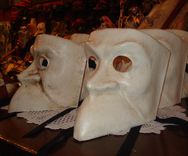
Among the most known Venetian masks there is the Bauta.
It was worn both by men and by women, characterized by a white mask for the
face, a black cloak (called "tabarro") and the typical Venetian hat of the
eighteenth century, the black tricorno. The Venetian masks mostly used
by the common people were the Bernardone or Bernardon
and the Gnaga: the first one pretented being ill, the second
one was a man disguised like a woman. The Mattaccino was the
clown of the carnival that, repeating an old folk custom, threw eggs full of
perfumes to his friends overlooking from the windows. The
Moretta was one of the Venetian masks most prefered by women.
It was painted in a black colour and was oval-shaped. It was secured to the
face by a small button attached to the masks and retained by the mouth of
Venetian women.
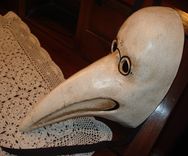
Among the most bizarre
masks is the Medico della Peste (Doctor of the Plague).
It's easily recognizable for its long nose like that of a stork. Originally
this wasn't a mask but was actually used to protect the Doctors of the Plague
that had a contact with the sick people of this awful disease. This illness
killed half of the Venetian people during the two pestilences that menaced
Europe in both 1576 and 1630. The Medici della Peste inserted in the
beak of the masks some aromatic grasses, and they worn glasses and
touched the sick people only with a wood wand. All of these tools were
considered indispensable to avoid being infected. Other typical costume
is Zanni having white and green
stripes, known also by the name of Brighella.
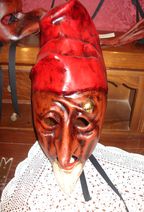
Among the most famous Venetian masks can include that of Harlequin,
which has origins in Bergamo. He is easily recognizable for his multicolored
costume and for his continuous movements alternating with jumps. He was the
protagonist of one of the most famous comedy by Carlo Goldoni, "Harlequin
Servant of Two Masters." Pantalone is a senior, smart and
stingy. Typical among the Venetian masks of the Commedia dell'Arte,
the figure of Pantalone is a farcical character of the merchant of Venice
that has contributed so much with his trade to the richness of his city.
Often overwhelmed by the beauty of Venetian masks like Colombina
and Franceschina, he was also called Pantalon de' Bisognosi.
Pantalone was masterfully interpreted in the twentieth century by the great actor
Cesco Baseggio. The stage director that perhaps best directed
these two Venetian masks in Goldonian comedies was Giorgio Strehler.
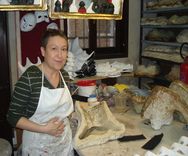
We were kindly given permission to use all of the photos shown on this page
by
La Bottega dei Mascareri. This workshop makes only
hand-crafted masks by papier mache. The Venetian masks are made and painted
entirely by hand. Massimo, Rita and Sergio have worked since 1984 with the
same passion that had the ancient Venetian maschereri. You can meet them from 9am to
7pm, all week, inside of the two workshops. The first one is located
50 metres from the Rialto Bridge (S. Polo, 80 - Phone and fax +39
041 5223857). The second one is located in Calle dei Saoneri (S.
Polo, 2720 - Tel. +39 041 5242887).
How to make Venetian masks
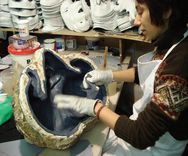
La Bottega dei Mascareri teaches us how to make Venetian masks.
At first we have to shape the clay sculpture of the mask we want to produce, then
adapt over a plaster cast (which will take the same form of the sculpture). You insert
the card in the plaster cast and gets it wet. We have to dry the paper on top of a
stove and then remove the mask, then cut the excess and finally color it. After this
process we have prepared our Venetian masks, ready to wear or display.
Affordable hotel in Venice
|